Cross of David which means. Where in temples six-pointed stars
Today, the six-pointed star causes so much embarrassment that when it is used in Orthodox symbolism, our people, “especially educated and knowing everything about the Jews,” begin to accuse the hierarchy almost of ecumenism and freemasonry. Let's see the same, what kind of a star is this and why is she more Orthodox than any other.
Hexagram (Greek hex - six; gramma - bar, line) - a six-pointed star, composed of two equilateral triangles with a common center. It is not a special symbol of Judaism. Hexagram is found for many centuries BC in India, Mesopotamia, Britain and other countries. It was widely used as an element of decor in the Middle Ages in Arab countries. The image of her can be found in the old Muslim cemeteries. Until the end of the 18th century, representatives of Judaism only occasionally turned to hexagram. Only from the beginning of the 19th century did Jews begin to accept it as a national emblem.
In the past two centuries, it has often been depicted in synagogues, in Jewish publications, on grave monuments. With the formation of Jewish statehood, the six-pointed star is depicted on the Israeli flag. The choice of this sign has no support in the religious or historical tradition of Judaism. The names “shield of David” (Magen David) and “seal of Solomon” (sigillum Solomonis) are conditional.
The connection of the hexagram with these two great kings of biblical history can not be traced. The Hebrew warriors had two types of shield: a large oblong to protect the whole body (Heb. Zinn) and a small round (Heb. Magen). There is no evidence that David did not have a round shield, but a six-toothed one. It is unlikely that King Solomon could have a hexagram inscription.
Sinai law forbade the image of “that which is in heaven above, and that on the earth below, and that in the water below the earth” (Ex.29: 4). Jews understood this prescription extremely broadly. A six-pointed star could be perceived as an image of "what is in the sky above."
Sometimes they refer to the fact that from the end of the 17th century Kabbalists used the hexagram. To this we must decisively say that there is not a single geometrical figure that has not been the subject of philosophical cosmological and occult mystical speculations over a long human history. If we, rejecting various false doctrines, do not perceive their symbolic interpretations, they will be for us only geometric forms, taken from nature created by God. We should not absolutize signs in order to prevent elements of magism into our consciousness.
In the Cathedral of Christ the Savior, the hexagram is present for decorative and aesthetic purposes.
The Lord Jesus Christ, after the revelations given to the visionary, confirming His Messianic dignity, calls Himself: Alpha and Omega, the beginning and the end, the First and the Last. With the help of the first and final letters of the Greek alphabet, He points to the fullness contained in Him.
Such a figurative expression was also used by Jewish scribes: “from Aleph to Tava”. The expression Alpha and Omega means that Christ is the true God. Earlier in the text, this image was twice applied to the God Almighty (cf. Rev.1: 8; 21: 6). Identical in the meaning of the expression First and Last. It is found in the Old Testament: “Thus says the Lord, the King of Israel, and his Redeemer, the Lord of hosts: I am the first and the last, and there is no God besides Me” (Is.44: 6; Is.48: 12). The absolute completeness of God is also indicated by the combination of the words “beginning and end”.
Continuing to confirm His divine dignity, Jesus Christ applies to Himself images and expressions that indicate ancient prophecies about Him: “The star of Jacob rises, and the staff of Israel rises” (Num.24: 17). The Holy Apostle Peter confirms that this expression refers specifically to Christ: “And besides, we have the surest prophetic word; and you do well that you speak to him as to a lamp shining in a dark place, until the day dawns and the morning star rises in your hearts ”(2 Pet. 1: 18-19). The Savior calls Himself the morning star, because it foreshadows the rising of the sun, which will drive away the darkness of night, the darkness of sin and death. "Whoever overcomes and keeps My works to the end, I will give authority over the Gentiles<…> and I will give him the morning star (Rev.2: 26,28). The promise of the morning star is the promise of Christ himself.
The expression "the root and descendant of David" is closely related to the prophecy of Isaiah: "And the industry will come from the root of Jesse, and the branch will grow from its root; and the Spirit of the Lord, the spirit of wisdom and intelligence, the spirit of counsel and strength, the spirit of knowledge and piety will rest upon him ”(Is.11: 1-2; cf.“ The Spirit of the Lord is upon Me ”, Lk.4: 18). Jesse was the father of David. The words root of Jesse, as well as the root of David, indicate that Jesus is the promised God by the prophets Messiah, who will come from the royal lineage of David. He is not only the fulfillment of prophecy, but at the same time there is that eternal root from which David came.
In Orthodoxy there is no special image of the morning star.
Orthodox Christianity has its own symbols. The eight-pointed star is one of them. Each of the symbols characterizes Orthodoxy in a certain way. Probably everyone at least once thought about what the eight-pointed star in religion means and not only. After all, she met in the culture of many nations in different eras. Surely and its value is diverse. To understand all this, it is necessary to trace its appearance in the history of mankind and in the symbolism of Orthodox Christianity.
Star with eight rays
In Christianity, this or the symbol According to the Holy Scriptures, it was lit in heaven when the Messiah was born. Her eight rays were brighter than other stars. Seeing them, the ancient sages (the Magi) remembered the prophecies and realized that the long-awaited Savior was born. They hurried east to worship the Son of God. The Bethlehem star pointed the way to the elders, moving in front, until it stopped above the place where Jesus was born.
In the cave of the Nativity there is the Star of Bethlehem. How many rays on it are known for certain. The place of the birth of Jesus is indicated by a silver star with fourteen rays. This number is not accidental. It symbolizes the stops on the Way of the Cross of Jesus in Jerusalem. 
Bethlehem star. History of
Today in Orthodox churches there is an eight-pointed star, the meaning of which can be understood by referring to the history of its appearance.
But initially the Bethlehem star was with five rays, according to the number of wounds of Jesus Christ. She also symbolized health: the number of fingers, the sense organs. But its main meaning was in the human nature of Christ.
In the Renaissance, the star was associated with the occult. And upside down, it became a symbol of Satan. But the Christians considered this option a sign of the rebirth of Christ. And even canonized by the church as a saint, Constantine had a seal with an inverted five-pointed star. It was he who made Christianity the state religion.
For Russia, historically, the symbol in the form of a star with five rays is alien. It is more customary to personify him with Judaism and Freemasonry. Although during the years of Soviet power, a star with five rays was chosen as the state symbol. 
Eight-pointed star in Orthodoxy. Background appearance
The five-pointed star of Bethlehem was replaced by a six-rayed star in about the fifteenth century. In general, this symbol appeared at the beginning of the Neolithic period. He meant six sides of the world. Everyone knows that there are four of them, but, for example, the inhabitants of ancient India, seeing a symbol with so many rays, understood its meaning as "six sides of the horizon."
Then, in one of the periods, in Russia there was a seven-pointed Bethlehem star. Once magicians wore the same symbol as the distinctive sign, but indicating the planet near each ray.
The value of the eight-pointed star in Russia
And finally, an eight-pointed star appeared - a symbol known in Russia since ancient times. Long before the twentieth century, among the inhabitants of Ancient Russia, even in pagan times, it meant the presence of the main deity. The image of such a star was placed on military banners, clothing, and various household items and worship.
In Orthodox Russia, the eight-pointed star was equally important. After all, it caught fire in the sky at the time of the birth of our Savior and led the Magi to the place where Jesus was born.
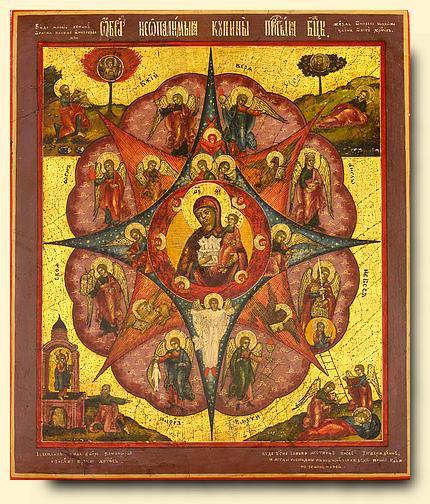
The eight-pointed star in iconography
Today, this sign is present in all Orthodox churches, symbolizing Russia. A star with eight rays can be found on all Russian icons of the Mother of God, the patroness of our Fatherland. About us, in Russia, they say about this symbol: the star of the Virgin, Russian, and also the Bethlehem.
As mentioned above, the icons of the Blessed Virgin Mary depict an eight-pointed star, the value of which is very important in Orthodoxy. This is understandable only by the mere fact that the symbol is located on the shoulders and head of the Virgin Mary. The icon "Burning Bush" and the whole image of the Mother of God are inscribed in an octogram (this is also the name of a symbol with two squares superimposed on each other, forming an eight-pointed symbol). The star is closely connected with the Virgin Mary, her secret.
If we recall the meaning of the symbol with eight rays, then by tradition it was understood as eternity, unshakable stability and going beyond the limits of this world. The octogram is also the sign of Paradise, the Heavenly Jerusalem and the final Transfiguration.
The value of the stars in different nations
The eight-pointed star is a symbol of balance, order, creation, if it is inscribed in a circle. So in antiquity they designated the calendar, the seasons (everything material changes, but the main thing remains the same).
The eight-pointed star is found in the cult of Latvians, Udmurts. In the form of a double cross or with forked ends, it can be seen in folk ornaments among the Finns and Karelians, as well as among northern peoples (for example, Finno-Ugric peoples). Here it means guiding and rebirth, it is a symbol of light and glory. 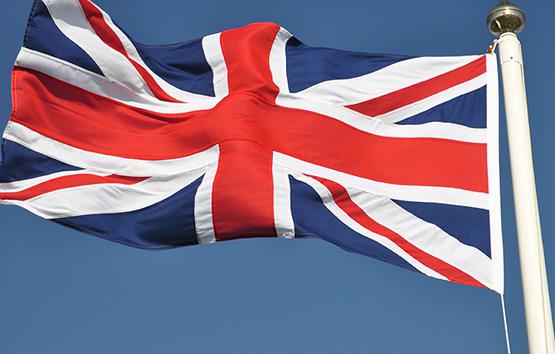
In addition, a star with eight rays can be found on the emblems of the Republic of Karelia, Likhoslavl and its region (whose inhabitants are also Karelians), Colombia, Peru. On the flags of Great Britain and the Philippines, octal symbolism is also traced.
The eight-pointed star, the meaning of which among the Egyptians was the identity of the divine sign, is also found among the Sumerians. In their language, it was this symbol that designated the word, which translates as "god, star, sky".
It is believed that the eight-pointed sign symbolizes seven periods in the history of mankind, and the eighth ray - the life of the next century. That is the time when the kingdom of God comes.
Star in the tradition of Christians
Eight-pointed has always been the main on the tops of the festive firs. She served as decoration in houses and on the street. During Soviet times, the star was replaced by a five-pointed.
Children were given an eight-pointed Bethlehem star for well-being and happiness. 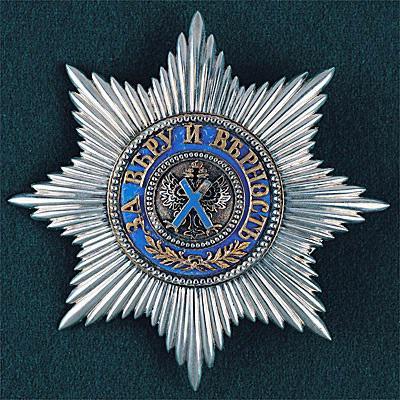
As the church tradition says, one of the apostles brought the news of the Christian faith to the Russian land before anyone else. Apparently, therefore, in Tsarist Russia, the highest award, which took the form of an eight-pointed star, was also called Today it also has a high status, returned by presidential decree in 1998.
The Bethlehem star, however many rays it may have, is of great importance in the history of Christianity. The wise men, led by her, found out where the Savior was and told the world about his Birth. Today, this symbol, as always, is a guide for believers, recalling that the material and the spiritual are interconnected. But if one passes without a trace, then the other is eternal and imperishable. Striving for life in the kingdom of God, we must remember that in this world everyone can become a guiding star for someone, doing good deeds and thus approaching the Lord. Maybe this is precisely the true meaning of the symbol with eight rays. Peace and harmony to you!
Orthodox Christianity has its own symbols. The eight-pointed star is one of them. Each of the symbols characterizes Orthodoxy in a certain way. Probably everyone at least once thought about what the eight-pointed star in religion means and not only. After all, she met in the culture of many nations in different eras. Surely and its value is diverse. To understand all this, it is necessary to trace its appearance in the history of mankind and in the symbolism of Orthodox Christianity.
Star with eight rays
In Christianity, it is the Star of Bethlehem or the symbol of the Birth of Jesus Christ. According to the Scriptures, she was lit in heaven when the Messiah came into the world. Her eight rays were brighter than other stars. Seeing them, the ancient sages (the Magi) remembered the prophecies and realized that the long-awaited Savior was born. They hurried east to worship the Son of God. The Bethlehem star pointed the way to the elders, moving in front, until it stopped above the place where Jesus was born.
In the cave of the Nativity there is the Star of Bethlehem. How many rays on it are known for certain. The place of the birth of Jesus is indicated by a silver star with fourteen rays. This number is not accidental. It symbolizes the stops on the Way of the Cross of Jesus in Jerusalem.

Bethlehem star. History of
Today in Orthodox churches there is an eight-pointed star, the meaning of which can be understood by referring to the history of its appearance.
But initially the Bethlehem star was with five rays, according to the number of wounds of Jesus Christ. She also symbolized health: the number of fingers, the sense organs. But its main meaning was in the human nature of Christ.
In the Renaissance, the star was associated with the occult. And upside down, it became a symbol of Satan. But the Christians considered this option a sign of the rebirth of Christ. And even canonized by the church as a saint, the Roman emperor Constantine had a seal with an inverted five-pointed star. It was he who made Christianity the state religion.
For Russia, historically, the symbol in the form of a star with five rays is alien. It is more customary to personify him with Judaism and Freemasonry. Although during the years of Soviet power, a star with five rays was chosen as the state symbol.

Eight-pointed star in Orthodoxy. Background appearance
The five-pointed star of Bethlehem was replaced by a six-rayed star in about the fifteenth century. In general, this symbol appeared at the beginning of the Neolithic period. He meant six sides of the world. Everyone knows that there are four of them (east, west, north, south), but, for example, the inhabitants of ancient India, seeing a symbol with so many rays, understood its meaning as "six sides of the horizon."
Then, in one of the periods, in Russia there was a seven-pointed Bethlehem star. Once magicians wore the same symbol as the distinctive sign, but indicating the planet near each ray.
The value of the eight-pointed star in Russia
And finally, an eight-pointed star appeared - a symbol known in Russia since ancient times. Long before the twentieth century, among the inhabitants of Ancient Russia, even in pagan times, it meant the presence of the main deity. The image of such a star was placed on military banners, clothing, and various household items and worship.
In Orthodox Russia, the eight-pointed star was equally important. After all, it caught fire in the sky at the time of the birth of our Savior and led the Magi to the place where Jesus was born.

The eight-pointed star in iconography
Today, this sign is present in all Orthodox churches, symbolizing Russia. A star with eight rays can be found on all Russian icons of the Mother of God, the patroness of our Fatherland. About us, in Russia, they say about this symbol: the star of the Virgin, Russian, and also the Bethlehem.
As mentioned above, the icons of the Blessed Virgin Mary depict an eight-pointed star, the value of which is very important in Orthodoxy. This is understandable only by the mere fact that the symbol is located on the shoulders and head of the Virgin Mary. The icon "Burning Bush" and the whole image of the Mother of God are inscribed in an octogram (this is also the name of a symbol with two squares superimposed on each other, forming an eight-pointed symbol). The star is closely connected with the Virgin Mary, her secret.
If we recall the meaning of the symbol with eight rays, then by tradition it was understood as eternity, unshakable stability and going beyond the limits of this world. The octogram is also the sign of Paradise, the Heavenly Jerusalem and the final Transfiguration.
The value of the stars in different nations
The eight-pointed star is a symbol of balance, order, creation, if it is inscribed in a circle. So in antiquity they designated the calendar, the seasons (everything material changes, but the main thing remains the same).
The eight-pointed star is found in the cult of Latvians, Udmurts. In the form of a double cross or with forked ends, it can be seen in folk ornaments among the Finns and Karelians, as well as among northern peoples (for example, Finno-Ugric peoples). Here it means guiding and rebirth, it is a symbol of light and glory.

In addition, a star with eight rays can be found on the emblems of the Republic of Karelia, Likhoslavl and its region (whose inhabitants are also Karelians), Colombia, Peru. On the flags of Great Britain and the Philippines, octal symbolism is also traced.
The eight-pointed star, the meaning of which among the Egyptians was the identity of the divine sign, is also found among the Sumerians. In their language, it was this symbol that designated the word, which translates as "god, star, sky".
It is believed that the eight-pointed sign symbolizes seven periods in the history of mankind, and the eighth ray - the life of the next century. That is the time when the kingdom of God comes.
Star in the tradition of Christians
The eight-pointed Christmas star has always been at the top of the festive fir trees. She served as decoration in houses and on the street. During Soviet times, the star was replaced by a five-pointed.
Children were given an eight-pointed Bethlehem star for well-being and happiness.

As the church tradition says, one of the apostles brought the news of the Christian faith to the Russian land before anyone else. Apparently, therefore, in Tsarist Russia, the highest award, which took the form of an eight-pointed star, was called the Order of St. Andrew. Today, he also has a high status, returned by presidential decree in 1998.
The Bethlehem star, however many rays it may have, is of great importance in the history of Christianity. The wise men, led by her, found out where the Savior was and told the world about his Birth. Today, this symbol, as always, is a guide for believers, recalling that the material and the spiritual are interconnected. But if one passes without a trace, then the other is eternal and imperishable. Striving for life in the kingdom of God, we must remember that in this world everyone can become a guiding star for someone, doing good deeds and thus approaching the Lord. Maybe this is precisely the true meaning of the symbol with eight rays. Peace and harmony to you!
A six-pointed star is formed by the imposition of equilateral triangles on each other. A star with six angles is called a hexagram.
The six-pointed star is depicted on the flag of Israel and is the symbol of the entire Jewish people. With the formation of the Israeli state there was a lot of controversy over whether the star of David could be used under the flag of the country. Today, the flag of Israel is represented by two horizontal blue lines, with the Star of David in their center.
This sign is often associated with Judaism. In addition to Judaism, the hexagram is used in other religions and teachings - Islam, the occult, the eastern directions. This symbol has other names - Seal of Solomon, Star of David, Star of Goliath. Modern New Age culture also uses this symbol.
The most common opinion is that the sales Jews borrowed this sign on the banks of the Nile about three thousand years ago. There they served the white pharaohs as slaves. More specifically, this symbol was borrowed from a secret list of magical signs from ancient sages.
The values of the hexagram set. In Christianity, the six-pointed star is as important as the six days of the creation of the world. Also according to the Bible, the six-pointed star represents the star of Bethlehem. The sign of the marriage of earth and sky in Christianity is represented by triangles superimposed on each other, the tops of which are directed in opposite directions - this is what the star of David looks like.
The occult-theosophical direction embodies the six-pointed star, as the perfection of the universe. This direction considers the star as the product of the female number 2 and the male number 3.
The eschatological interpretation connects the hexagram with the number of the beast 666 and the antichrist. This is explained by the fact that the figure has six corners - in a circle there are six small triangles and six sides of the internal hex.
In tantrism, this symbol speaks of the harmony of two worlds. This is the world of the mother - the edge of the triangle is at the top and the world of the spirit - the edge of the triangle is directed down. Another direction of Tantrism considers hexagram as a symbol of unity of feminine and masculine principles. The downward angle of the triangle is a symbol of the feminine, and the upward angle of the triangle is the symbol of the masculine.
Another legend says that the six-pointed star was engraved on the ring of King Solomon. It was through this ring that the king could command spirits. In these legends, the hexagram is called the seal of Solomon or the star of Solomon.
The philosopher's stone, the hexagram, began to symbolize with the advent of alchemy. The figure is represented by two opposite triangles, it was considered as a unity of opposites. Not often, but there are hexagrams with 12 zodiac signs inscribed over the six corners of a symbol. More often hexagram correlated with the ancient planets. A similar image is present on the book Opus Medico-Chymicum. Its author is the alchemist doctor Johan Daniel Milius. It was published in Frankfurt in 1618. The hexagram is surrounded by two Latin phrases "Water and fire will redeem everything" and "The secret will become apparent and vice versa."
The generally accepted esoteric symbol of the planetary hexagram was in the XVIII century. Also, this symbol is actively used in Freemasonry.
Very good six-pointed star is used in the traditions of the east. The Hindu tradition considers two triangles, which are superimposed on each other by opposite vertices, as the connection of Kali and Shiva - the generation and destruction of the world. The six syllables of an important prayer in Buddhism are associated with the six angles of the hexagram.
Today, on the eve of the celebration of the 70th anniversary of the Victory in the Great Patriotic War, a dispute broke out - under which symbol did our great fathers, grandfathers and great-grandfathers fight and die for our freedom?
Under whose symbol is the Kremlin?
Inquisitiveness pushed me to view the available materials on the Internet.
Despite the fact that the five-pointed star, the pentagram is considered a symbol of evil forces, I was surprised to find this element used twice in the Church of the Nativity in Bethlehem.
Five-pointed star over the Temple of the Nativity in Bethlehem.

An outdoor kyote for the icon in the symbolism of which uses a five-pointed star of red color in the Church of the Nativity in Bethlehem.
There are opinions that the five-pointed star is an archaic-traditional image of the Bethlehem star, which is found in the mosaic decoration:
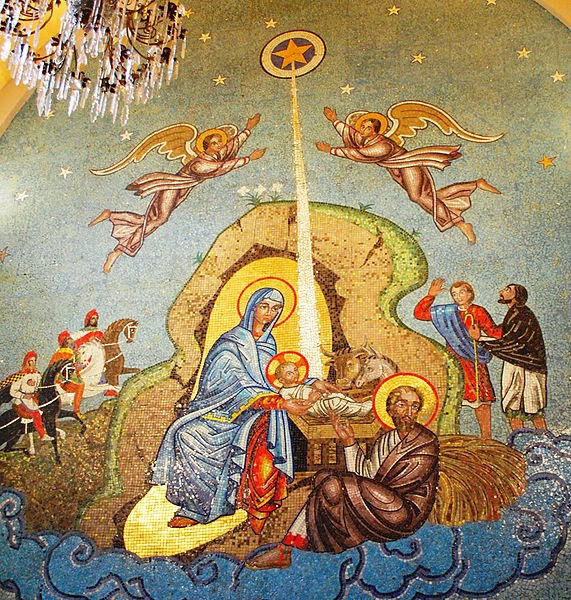
Red Star in the House of the Lord. Mosaic panel from America, Mexico.
The inverted pentagram is a symbol of the Transfiguration of the Lord in traditional iconography:
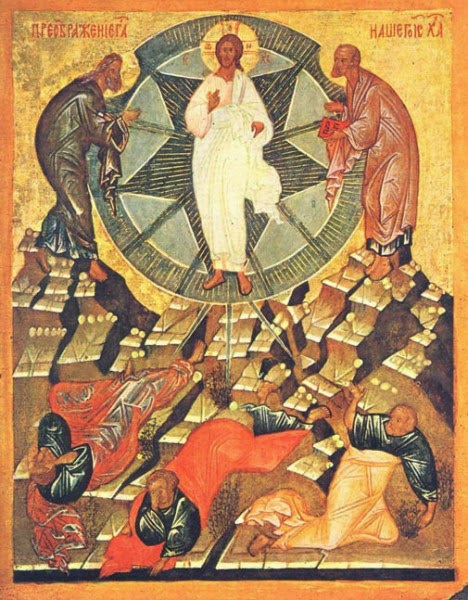
Gradually the inverted pentagram became the symbol of the transfiguration of Christ, as well as his descent into the world (therefore, it is directed downwards). In particular, we can recall the famous icon of Andrei Rublev, “The Transfiguration of God”, written by him at the beginning of the 15th century, where Christ is depicted against the background of a clearly visible inverted pentagram.

It must be emphasized here that Andrei Rublev is one of the most famous and most revered Orthodox icon painters, who, by the way, was canonized. He was the author of many rules that later became the canons of icon painting and the contribution he made is still felt in icon painting.
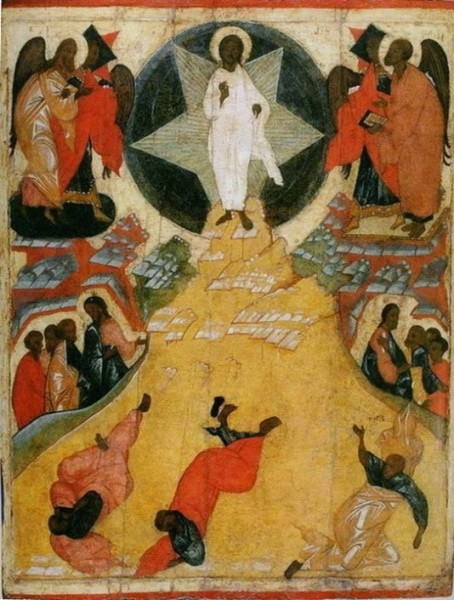
Associations of the Savior with a five-pointed star were also sometimes argued by quotations from the Bible, for example: “I, Jesus, sent My angel to testify this to you in the churches. I am the root and the offspring of David, the bright and morning star ”(Rev. 22:16).
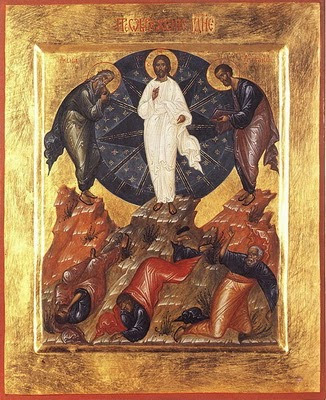
Copy of the icon of Andrei Rublev "Transfiguration"
Three stars on the maforia of the Mother of God - one on the forehead and two on the shoulders - are traditional elements of the Virgin iconography, signs of the virginity of Mary before, during and after the birth of Christ.
![]()
The icon of the Mother of God "Affection" ("Joy of all joys").
The second half of the XVIII century.
Wood, gesso, oil. Salary: the beginning of the XX century. Silver, embossing, engraving, filigree enamel, precious stones, gilding.
Patriarch's residence in Moscow.
The Church of the Savior on Spilled Blood in St. Petersburg is replete with images of pentagrams. The above are not exceptions, but only vivid and well-known examples.
In most major temples, churches, or basil, you can, in one form or another, find an image of a pentagram.

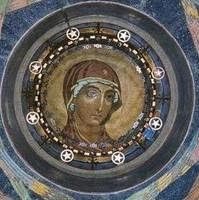
This topic was discussed several times on the Internet and in forums.
There are quite good articles on this topic, in which there is enough evidence that the pentagram is one of the oldest Christian symbols, of course, without a sickle and hammer.
Without giving examples of its use by the God-fighting, we can say that, regardless of this, it cannot lose its sacred significance for the Christian.
If this symbol is used in two ways, then probably he needs to return to former glory.
If the providence of God was meant for our parents and grandfathers, and ourselves to serve, fight and die under this Christian symbol, then you need to know that this symbol is Orthodox.
And the stars above the capital are not symbols of evil, but symbols of wide significance in Orthodoxy — the wounds of the Savior, the Transfiguration of God, the Star of Bethlehem and Christmas, the stars on the maforia of Our Lady.
Yes, the godless men used this symbol, yes - ignoramus, yes - people who want to destroy Orthodoxy, but perhaps no one can say for sure that these symbols were used by the Soviet authorities exclusively for ritualistic satanic purposes.
Historically, the pentagram has become a symbol of the great victims of the peoples inhabiting the territory of the first Russian Empire, then the USSR - the victims of innocents and the victims who deliberately gave their lives for the future.
This symbol, as one of the oldest symbols of the atoning sacrifice of the Savior, must be rehabilitated and, as an element of the monuments of military glory, receive Christian significance.
New Articles
- What is the highest peak of the Ural Mountains
- The most ancient religions in the world
- What continents are washed by the Atlantic Ocean?
- Can I wear jewelry of the deceased?
- Snake, Bowl and Staff: The Origin of Medical Symbols
- Interesting facts about hares
- Names of famous brands in other countries
- Karelo Finnish epic kalevala protagonists
- 17 18 weeks pregnant sensations
- Why do people become so aggressive
Popular articles
- Expression twice in one river, meaning and meaning
- Gusli - musical instruments
- Report: Temperature Scales and Thermometers
- Which side to sew on chevron
- How to draw emblems for school
- Unusual rivers of the world and the rivers of Russia - Rivers with sour water
- Numb of the little finger on the right hand: causes and methods of treatment
- Why development is important for a person
- Constellations from ancient atlases
- What happens at 31 weeks
